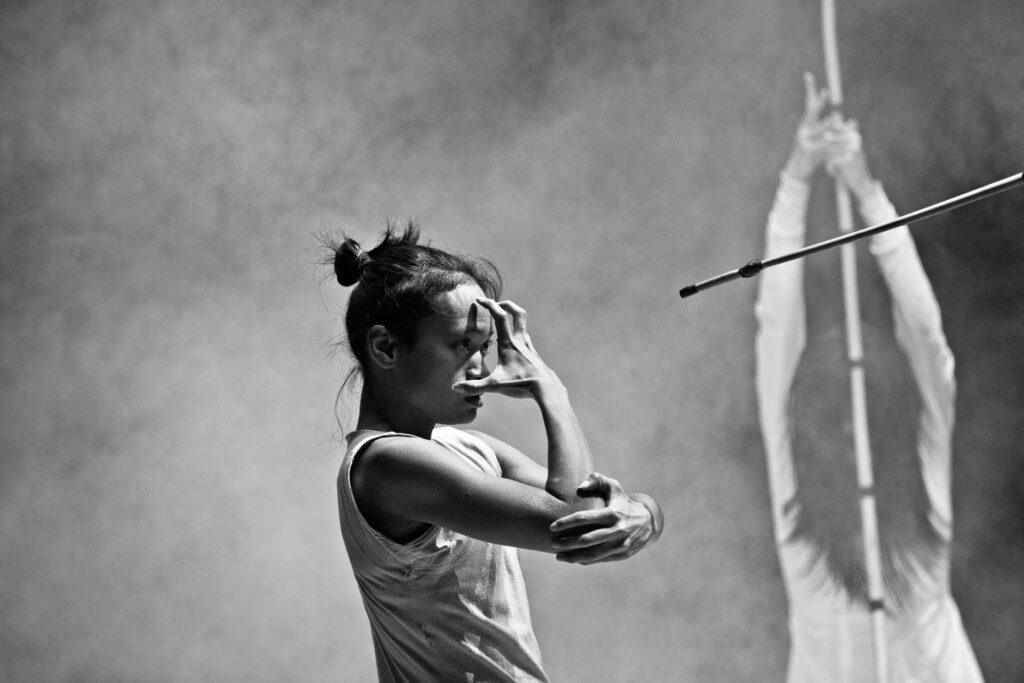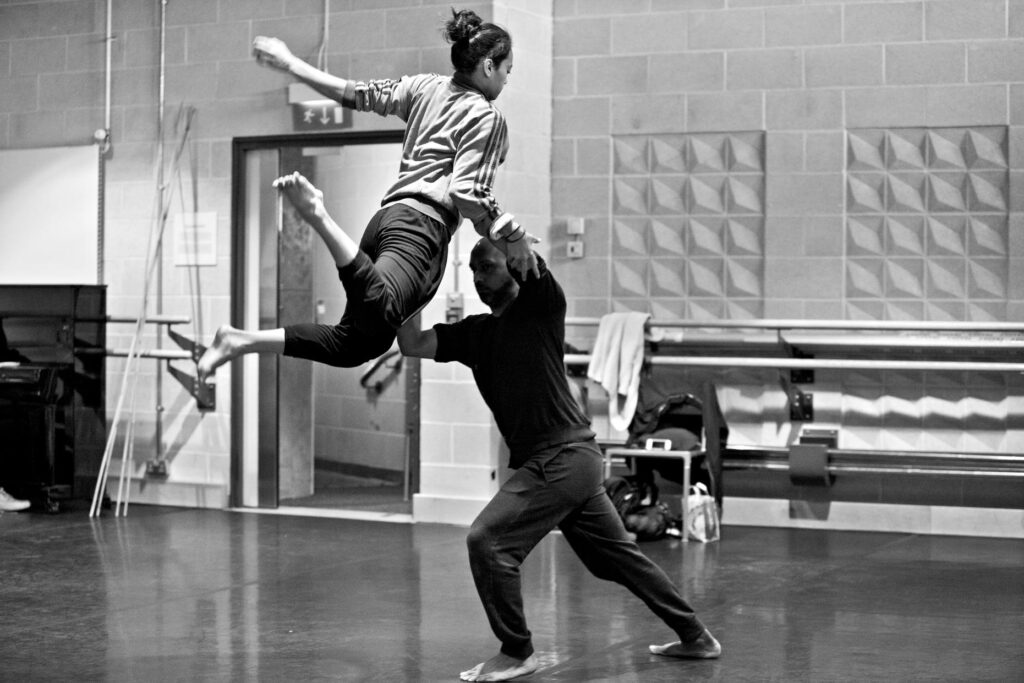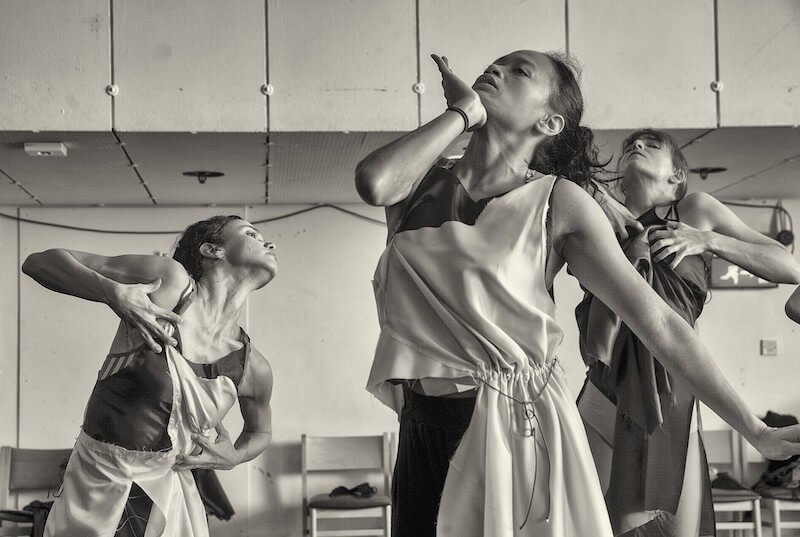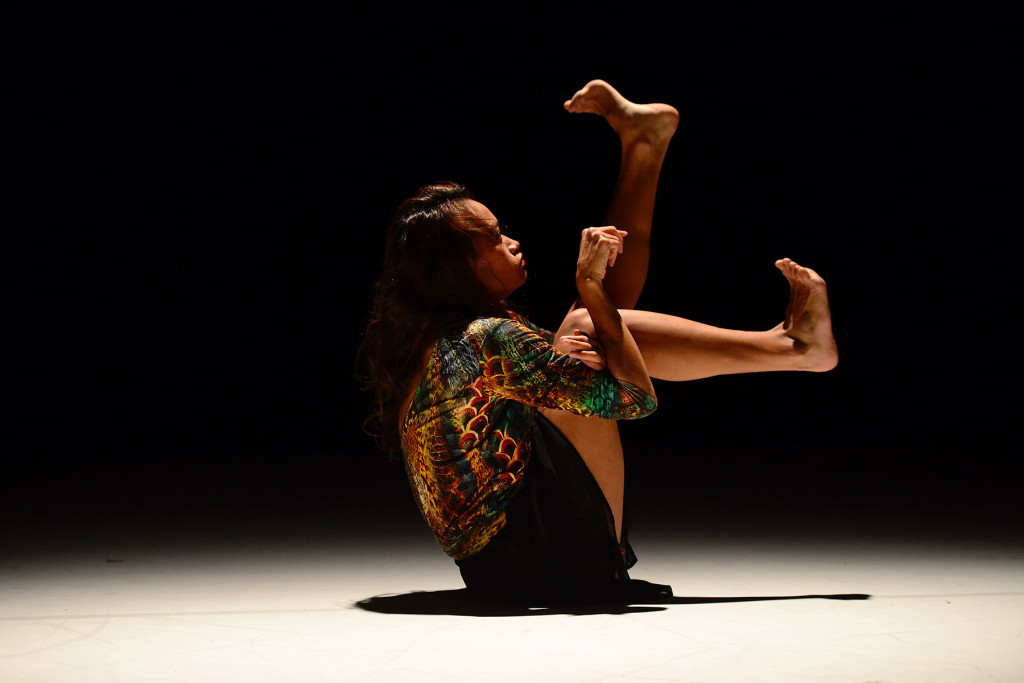ENGLISH BELOW
Ex danzatrice della Compagnia di Akram Khan oggi Joy è assistente alle coreografie e ripetiteur nonché coreografa freelance. Nata a Los Angeles e cresciuta a Friburgo in Germania, oggi vive a Berlino. Alcuni giorni fa si è collegata da Londra per incontrarci su Skype. Di mattina, prima di iniziare la giornata di prove, ci ha raccontato della sua storia ripercorrendo il lavoro con Khan arrivando poi alla sua attività di oggi.

Ricordi il primo incontro con Akram Khan? Che percezioni hai avuto e come sono cambiate nel tempo?
Penso che il mio primo incontro con Khan non sia stato granché speciale perché, impegnata con una produzione del Cirque du Soleil, non ho potuto partecipare all’audizione ufficiale. La compagnia è stata molto generosa però a offrirmi l’opportunità di fare un’audizione privata con il direttore delle prove Jose Agudo che ha poi mostrato il video a Khan. Quindi, attraverso il video, Khan mi ha scelta e invitata per un suo nuovo progetto nel 2013. È stato strano perché io non lo avevo mai incontrato e la prima volta è successo in Francia per una cena con tutta la compagnia. Lì abbiamo parlato per la prima volta, ricordo in particolare dello spettacolo su Michael Jackson che avevo appena fatto con il Cinque du Soleil.
Nel primissimo periodo ricordo di essermi sentita molto nervosa, ero l’unica nuova nella compagnia quindi Khan conosceva già tutti e mi sentivo sotto esame. Ho imparato tantissimo: il lavoro era molto giocoso con tantissime improvvisazioni, ma anche con tanto materiale coreografico. Khan usava due strade per conoscere al meglio i nostri punti forti ma soprattutto la nostra personalità, un aspetto importante per quel lavoro caratterizzato da diversi personaggi.
Ricordi il nome del progetto?
Era iTMOi (nella mente di Igor). Ciò che mi ha messo alla prova è stata la fisicità del lavoro, le rotazioni, i miei piedi bruciavano al pavimento. Khan chiedeva tantissima energia ed era anche molto sfidante in termini di ritmo. Io non desideravo altro, ero in quella fase in cui stavo imparando e volevo farlo il più possibile. Khan è una persona davvero rispettosa e sa come essere esigente con i suoi danzatori spingendoli sempre al di fuori della loro comfort zone.
Com’è stato ballare con Akram Khan?
Danzare con lui è stupendo. Abbiamo danzato insieme in Until the lions. C’era tantissima potenza che riuscivo a cogliere e dare ai suoi pezzi; lui non si aspettava altro che il massimo. Bisogna essere sempre focalizzati sul lavoro senza mai marcare. Al contempo ci permetteva di portare la nostra creatività all’interno dei suoi pezzi.
Qual è il training quotidiano della compagnia?
Dipende anche qui dal progetto. Solitamente il direttore delle prove si occupava della lezione di riscaldamento e rafforzamento con una lezione di danza contemporanea. Poi danzavamo anche il Kathak – che è la base del lavoro di Khan insieme a un mix di danza tradizionale indiana, danza contemporanea e altri stili di danze folkloriche. Di base si trattava di danza contemporanea o di un altro tipo di training fisico (come lo yoga), poi il Kathak e poi le prove. Il riscaldamento durava più o meno due o tre ore. Il suo è un lavoro davvero corposo e in quel contesto non importava mai quanto si riuscisse a fare in termini di quantità. Ciò che contava era sempre di avere una buona preparazione fisica ed essere pronti per le prove. Alla fine della giornata spesso facevamo anche degli esercizi per migliorare le nostre capacità ritmiche, con pattern ritmici che cantavamo e seguivamo con i passi, spesso molto difficili!
Cosa vuoi trasmette del lavoro della compagnia, soprattutto per coloro che non hanno mai fatto esperienza del lavoro di Khan?
Credo che si debba avere innanzitutto la volontà che ti permette di impegnarti al massimo. Invito tutti coloro che parteciperanno a fidarsi del viaggio che faremo e di permettere a loro stessi di andare a fondo della ricerca e mettendola anche in discussione.
Ciò che importa è la qualità, non conta la quantità di cose che si è in grado di fare. Non importa quanto posso fare ma come posso farlo. Questo vale pe tutto dal movimento più virtuosistico fino al semplice stare in piedi fermi. Il focus è sull’estremità e non su quale movimento mi rende un grande interprete; spingerò molto in questa direzione, perché essere un bravissimo danzatore non significa essere un grande performer e viceversa. Tutto sta nel come si trasmette al pubblico, di certo bisogna avere la tecnica ma non solo. La combinazione dei diversi aspetti è la soluzione! Per questo è importante capire il miglior approccio mentale per danzare, che include sacrificio e impegno. Bisogna anche credere e fidarsi nel percorso che si fa e permettere di andare sempre più a fondo.
Ora che sei anche coreografa, quali esperienze del passato pensi ti abbiano segnato di più?
Il mio background da danzatrice è stato sempre versatile: ho iniziato con la danza classica, poi con la danza folklorica filippina, mia madre mi ha insegnato la danza tradizionale asiatica poi ho studiato danza contemporanea, jazz e hip hop.
Sono sempre stata curiosa, volevo ispirarmi a più stili e ambiti di danza: quello professionale rimanendo legata anche al senso di comunità che ha la danza popolare.
Ciò che porto con me è un mix di stili e penso anche al Kathak di Akram. Da coreografa sto provando a connettere tutto ciò che ho provato nel mio corpo per raggiungere una libertà di espressione personale. Questa modalità mi proviene da Khan che dice sempre: «Trova il tuo modo». Mi ci è voluto un po’ per capirlo.
Un’ultima cosa importante è il lavoro di Khan con diversi personaggi, in Untile the Lions e iTMOi ad esempio. Lui usa storie ma invita ogni volta ogni danzatore a creare la propria.

Do you remember your first meeting with Akram Khan? What kind of emotions did you experience and how have these changed during the time working with him?
I don’t think my first encounter was particularly special, as I had to audition a second time. Coming from Cirque du Soleil, I wasn’t able to attend the official audition, so the company generously arranged a private audition with the rehearsal director, Jose Agudo. I auditioned with him, and he showed the video of my dance to Akram. Through that video, Akram invited me to join the initial research for a project in 2013. It was strange because I had never met him before; the first time we met was in France, with all the dancers gathered in a restaurant. We had a private conversation, particularly about Michael Jackson’s Cirque du Soleil show. Initially, I felt nervous with the company because the other dancers already knew each other, and I was the newcomer; it felt like a test. In the beginning, the dancing was very playful with lots of improvisation, but Akram also provided a lot of choreographic material. This allowed us to showcase our special skills and allowed Akram to get to know our personalities, especially for that project where there were different types of characters. I learned so much from that experience!
Do you remember the name of the project?
Yes, iTMOi (In the mind of Igor). What I really was mesmerised and challenged by was the grounding physicality and spins; my feet were burning on the floor. This was a special technique that really pushed and challenged me also in terms of rhythm. I really wanted that challenge because I was in the phase of learning as much as possible as a dancer. He is very respectful, but he really knows how to push people out of their comfort zone.
How was dancing with Akram Khan?
Dancing with him was amazing. We danced together on stage in Until the Lions.There was a lot of power that I was able to discover in his pieces. He expects you to really go for it, no marking, you need to be very focused. I really like the balance between his respectfulness and his ability to push boundaries While also allowing us to bring our own creativity to the work.
What physical training did you do with him daily?
It depends on the project. At the beginning we had the rehearsal director giving us a warmup, strengthening out the body, in contemporary dance. Initially, we would have the rehearsal director lead us through a warm-up session, focusing on strengthening the body, particularly in contemporary dance techniques. Then, we would delve into Kathak – which is the foundation of Akram’s work, blending Indian classical dance with contemporary and other folk dance styles. Essentially, the training consisted of contemporary dance or other forms such as yoga and Kathak, followed by rehearsals lasting around two to three hours. It is very consistent training, it does not matter how much you tour, the quantity; It is important to have a good base of physical fitness. At the end of the rehearsal, we used to improve our learning and rhythm with different and challenging patterns.
For those who don’t know your work, what is the physical focus that you want to convey to the dancers?
I believe there’s room for emotional investment. I invite dancers to trust the journey, allowing themselves to delve deeply into exploration and questioning. What matters most is the quality we bring to our movements, not the tricks or attempts to impress. The quantity is not important, not how much I can do but how I do it. From very virtuous physical movement versus just standing still. The focus lies in extremities, not which movement makes me a great performer. Of course, I will push in this direction, because being a great dancer does not mean great performer, and vice versa. It’s about how to transmit to the audience and space and of course, we have the technique so that combination is the answer. It is important to understand the best mental approach to dance, which involves sacrifice and commitment, you also need to have trust in the journey and allow yourself to go deep. It’s important the quality, how I do something, either a physical movement or just standing still.
As a choreographer now, which aspects of your work and past experiences have left a mark on your current endeavours?
My dancing background has been versatile: I started with ballet, Philippine folk dance, my mum taught me Asian folk dance, then contemporary dance, jazz, and hip hop, I also did hip hop battles! I was always curious, I wanted to be inspired by different styles and fields. Professional, of course, but also remaining close to the sense of community inherent in the popular dance. As a choreographer I’m trying to connect different styles that I have tried in my body, and I try to achieve the freedom to express through these different styles. As Akram says: “Find your way”. You get inspired by different techniques and styles and then make it your own, it took me a while to do that. Lastly, another thing is that I like working with characters. I worked with Akram on Until the Lions and iTMOi. He incorporates storytelling into his work, but he invites you every time to make it your own.

(revisione della traduzione a cura di Elettra Giunta)




